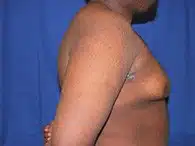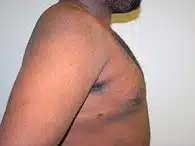
What is Gynecomastia?
Gynecomastia is a benign enlargement of the male breast, resulting in a fuller look in the pectoral area of a male’s chest. This could be due to a hormone imbalance or hormone therapy. It is a very common condition, with up to 50% of males experiencing it in their lifetime.
What Causes Male Breasts?
An accumulation of excess fatty tissue in the pectoral region, called pseudogynecomastia, is the cause of gynecomastia. Though not necessarily caused by extra fat, weight can play into the look of your breasts.
Determine whether or not your nipples have become enlarged, perky, or erect – this could be a sign that the glands in your breasts have become enlarged as well. If the tissue underneath your breast is more firm versus soft, this could be another sign of gynecomastia; this problem will need to be rectified via surgery, not through diet and exercise.
Other factors that may contribute to male breasts include:
- Medications
- Health conditions
- Drugs and alcohol
- Herbal products
What Are Your Options?
If changing your diet and implementing an exercise routine is not working to reduce the size of your chest, you may also choose to undergo male breast reduction or recontouring. Keep in mind that for some men, breast tissue cannot be reduced by diet and exercise alone. Often, teens will have enlarged breasts due to changing levels of sex hormones; however, in 90% of teens, their breasts will change shape and decrease in size on their own. Adult men are different; they may need to undergo surgery to correct this issue.









